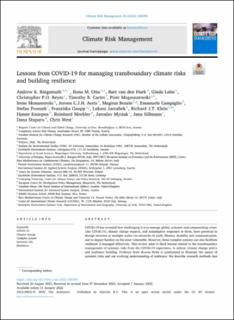Lessons from COVID-19 for managing transboundary climate risks and building resilience
| dc.contributor.author | Ringsmuth, Andrew K. | |
| dc.contributor.author | Otto, Ilona M. | |
| dc.contributor.author | van den Hurk, Bart | |
| dc.contributor.author | Lahn, Glada | |
| dc.contributor.author | Reyer, Christopher P.O. | |
| dc.contributor.author | Carter, Timothy R. | |
| dc.contributor.author | Magnuszewski, Piotr | |
| dc.contributor.author | Monasterolo, Irene | |
| dc.contributor.author | Aerts, Jeroen C.J.H. | |
| dc.contributor.author | Benzie, Magnus | |
| dc.contributor.author | Campiglio, Emanuele | |
| dc.contributor.author | Fronzek, Stefan | |
| dc.contributor.author | Gaupp, Franziska | |
| dc.contributor.author | Jarzabek, Lukasz | |
| dc.contributor.author | Klein, Richard J.T. | |
| dc.contributor.author | Knaepen, Hanne | |
| dc.contributor.author | Mechler, Reinhard | |
| dc.contributor.author | Mysiak, Jaroslav | |
| dc.contributor.author | Sillmann, Jana | |
| dc.contributor.author | Stuparu, Dana | |
| dc.contributor.author | West, Chris | |
| dc.date.accessioned | 2022-06-13T12:23:19Z | |
| dc.date.available | 2022-06-13T12:23:19Z | |
| dc.date.created | 2022-04-26T14:26:58Z | |
| dc.date.issued | 2022 | |
| dc.identifier.citation | Climate Risk Management. 2022, 35 . | en_US |
| dc.identifier.issn | 2212-0963 | |
| dc.identifier.uri | https://hdl.handle.net/11250/2998538 | |
| dc.description.abstract | COVID-19 has revealed how challenging it is to manage global, systemic and compounding crises. Like COVID-19, climate change impacts, and maladaptive responses to them, have potential to disrupt societies at multiple scales via networks of trade, finance, mobility and communication, and to impact hardest on the most vulnerable. However, these complex systems can also facilitate resilience if managed effectively. This review aims to distil lessons related to the transboundary management of systemic risks from the COVID-19 experience, to inform climate change policy and resilience building. Evidence from diverse fields is synthesised to illustrate the nature of systemic risks and our evolving understanding of resilience. We describe research methods that aim to capture systemic complexity to inform better management practices and increase resilience to crises. Finally, we recommend specific, practical actions for improving transboundary climate risk management and resilience building. These include mapping the direct, cross-border and cross-sectoral impacts of potential climate extremes, adopting adaptive risk management strategies that embrace heterogenous decision-making and uncertainty, and taking a broader approach to resilience which elevates human wellbeing, including societal and ecological resilience. | en_US |
| dc.language.iso | eng | en_US |
| dc.publisher | Elsevier | en_US |
| dc.rights | Navngivelse 4.0 Internasjonal | * |
| dc.rights.uri | http://creativecommons.org/licenses/by/4.0/deed.no | * |
| dc.subject | COVID-19 | en_US |
| dc.subject | Climate change | en_US |
| dc.subject | Complex system | en_US |
| dc.subject | Systemic risk | en_US |
| dc.subject | Resilience | en_US |
| dc.title | Lessons from COVID-19 for managing transboundary climate risks and building resilience | en_US |
| dc.title.alternative | Lessons from COVID-19 for managing transboundary climate risks and building resilience | en_US |
| dc.type | Journal article | en_US |
| dc.type | Peer reviewed | en_US |
| dc.description.version | publishedVersion | en_US |
| dc.source.pagenumber | 0 | en_US |
| dc.source.volume | 35 | en_US |
| dc.source.journal | Climate Risk Management | en_US |
| dc.identifier.doi | 10.1016/j.crm.2022.100395 | |
| dc.identifier.cristin | 2019236 | |
| dc.relation.project | EC/H2020/821010 | en_US |
| dc.relation.project | EC/H2020/820712 | en_US |
| cristin.ispublished | true | |
| cristin.fulltext | original | |
| cristin.qualitycode | 1 |
Tilhørende fil(er)
Denne innførselen finnes i følgende samling(er)
-
Journal articles [478]

